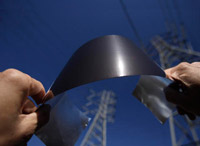Breakthrough in Thin-Film Solar Cells
 Scientists at Johannes Gutenberg University Mainz (JGU) have come out with positive news about increased efficiency of thin-film solar cells. As we know that scientists are trying to increase the efficiency of the solar cells so that they can be considered as serious alternative to the fossil fuels. Researchers at Johannes Gutenberg University Mainz (JGU) too are working at this angle. They opted for the computer simulations to probe deeper into the indium/gallium combination to increase the efficiency of Copper indium gallium (di)selenide (CIGS) thin-film solar cells. Till now CIGS has shown only about 20% efficiency though theoretically they can attain the efficiency levels of 30%.
Scientists at Johannes Gutenberg University Mainz (JGU) have come out with positive news about increased efficiency of thin-film solar cells. As we know that scientists are trying to increase the efficiency of the solar cells so that they can be considered as serious alternative to the fossil fuels. Researchers at Johannes Gutenberg University Mainz (JGU) too are working at this angle. They opted for the computer simulations to probe deeper into the indium/gallium combination to increase the efficiency of Copper indium gallium (di)selenide (CIGS) thin-film solar cells. Till now CIGS has shown only about 20% efficiency though theoretically they can attain the efficiency levels of 30%. Advantages of CIGS:
CIGS cells are cheaper than their counterpart silicon cells due to lower material and fabrication costs resulting in lowered manufacturing costs. CIGS has direct band-gap material therefore they exhibit a very strong light absorption tendency, and only 1-2 micrometers of CIGS is enough to absorb most of the sunlight. Conventional silicon photovoltaic cells are rigid but CIGS cells are flexible. Thin-film solar cells are slowly topping the popularity chart of solar market.
Working on the Efficiency of CIGS: Currently CIGS cells are showing efficiency of around 20%. These cells absorb sunlight through a thin layer made of copper, indium, gallium, selenium, and sulphur. The scientists at Mainz University headed by Professor Dr Claudia Felser are exploiting the computer simulations to find out the properties of CIGS. This research is a part of the comCIGS project. This project is financed by the Federal German Ministry for the Environment, Nature Conservation, and Nuclear Safety (BMU). The researchers are concentrating on the optimum proportion of indium/gallium puzzle. What ratio of indium/gallium would be ideal to increase the efficiency of CIGS? It was discovered earlier that the desired ratio should be 30:70, in practice; the highest efficiency level has been obtained with the exactly opposite ratio of 70:30.
Christian Ludwig who is the member of the Professor Felser’s team worked on the calculations using a hybrid method. This hybrid method included a combination of density functional calculations and Monte Carlo simulations. Dr Thomas Gruhn is the head of the theory group in the Prof. Felser’s team. He says, “Density functional calculations make it possible to assess the energies of local structures from the quantum mechanical point of view. The results can be used to determine temperature effects over wide length scale ranges with the help of Monte-Carlo simulations.”
Homogeneity of the material is the key to high efficiency:
Scientists find out that the indium and gallium atoms are not distributed evenly in the CIGS material; there is a phase when indium and gallium are completely separate. This separation happens at just below room temperature. Researchers also tried out various combinations of temperatures and discovered that the higher the temperature, the more homogeneous the material becomes. The more the lack of homogeneity of the gallium-rich material the lower the efficiency levels of gallium-rich CIGS cells. This phenomenon is discovered for the first time by Prof Felser’s team. The team also discovered a better way to manufacture CIGS solar cells. The research team says if gallium rich material is produced at higher temperatures, the material is notably more homogeneous. For maintaining the homogeneity, the gallium rich material should be cooled down rapidly.
Glass is used as substrate for solar cells. Glass has always restricted process temperatures. But Schott AG has been successful in inventing a special glass with which the process temperature can be increased. Naturally the cells would be more homogeneous. This would lead to the production of cells with a much greater efficiency level. Gruhn says, “We are currently working on large-format solar cells which should outperform conventional cells in terms of efficiency. The prospects look promising.”
You can return to the main Market News page, or press the Back button on your browser.

